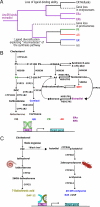Independent elaboration of steroid hormone signaling pathways in metazoans
- PMID: 19571007
- PMCID: PMC2715501
- DOI: 10.1073/pnas.0812138106
Independent elaboration of steroid hormone signaling pathways in metazoans
Abstract
Steroid hormones regulate many physiological processes in vertebrates, nematodes, and arthropods through binding to nuclear receptors (NR), a metazoan-specific family of ligand-activated transcription factors. The main steps controlling the diversification of this family are now well-understood. In contrast, the origin and evolution of steroid ligands remain mysterious, although this is crucial for understanding the emergence of modern endocrine systems. Using a comparative genomic approach, we analyzed complete metazoan genomes to provide a comprehensive view of the evolution of major enzymatic players implicated in steroidogenesis at the whole metazoan scale. Our analysis reveals that steroidogenesis has been independently elaborated in the 3 main bilaterian lineages, and that steroidogenic cytochrome P450 enzymes descended from those that detoxify xenobiotics.
Conflict of interest statement
The authors declare no conflict of interest.
Figures




Similar articles
-
Evolutionary genomics of nuclear receptors: from twenty-five ancestral genes to derived endocrine systems.Mol Biol Evol. 2004 Oct;21(10):1923-37. doi: 10.1093/molbev/msh200. Epub 2004 Jun 30. Mol Biol Evol. 2004. PMID: 15229292
-
Origin and diversification of steroids: co-evolution of enzymes and nuclear receptors.Mol Cell Endocrinol. 2011 Mar 1;334(1-2):14-20. doi: 10.1016/j.mce.2010.07.013. Epub 2010 Jul 21. Mol Cell Endocrinol. 2011. PMID: 20654689 Review.
-
Rapid birth-death evolution specific to xenobiotic cytochrome P450 genes in vertebrates.PLoS Genet. 2007 May 11;3(5):e67. doi: 10.1371/journal.pgen.0030067. Epub 2007 Mar 14. PLoS Genet. 2007. PMID: 17500592 Free PMC article.
-
Exploring metazoan evolution through dynamic and holistic changes in protein families and domains.BMC Evol Biol. 2012 Aug 3;12:138. doi: 10.1186/1471-2148-12-138. BMC Evol Biol. 2012. PMID: 22862991 Free PMC article.
-
Metabolic conversion as a pre-receptor control mechanism for lipophilic hormones.Eur J Biochem. 2001 Aug;268(15):4113-25. doi: 10.1046/j.1432-1327.2001.02359.x. Eur J Biochem. 2001. PMID: 11488903 Review.
Cited by
-
Lack of membrane sex steroid receptors for mediating rapid endocrine responses in molluscan nervous systems.Front Endocrinol (Lausanne). 2024 Aug 12;15:1458422. doi: 10.3389/fendo.2024.1458422. eCollection 2024. Front Endocrinol (Lausanne). 2024. PMID: 39188914 Free PMC article.
-
Proteome and Transcriptome Analysis of Gonads Reveals Intersex in Gigantidas haimaensis.BMC Genomics. 2022 Mar 3;23(1):174. doi: 10.1186/s12864-022-08407-w. BMC Genomics. 2022. PMID: 35240981 Free PMC article.
-
Transcriptional Regulators of Ecdysteroid Biosynthetic Enzymes and Their Roles in Insect Development.Front Physiol. 2022 Feb 8;13:823418. doi: 10.3389/fphys.2022.823418. eCollection 2022. Front Physiol. 2022. PMID: 35211033 Free PMC article. Review.
-
Genomic sequence analyses of classical and non-classical lamprey progesterone receptor genes and the inference of homologous gene evolution in metazoans.BMC Evol Biol. 2019 Jul 1;19(1):136. doi: 10.1186/s12862-019-1463-7. BMC Evol Biol. 2019. PMID: 31262250 Free PMC article.
-
Steroid Androgen Exposure during Development Has No Effect on Reproductive Physiology of Biomphalaria glabrata.PLoS One. 2016 Jul 22;11(7):e0159852. doi: 10.1371/journal.pone.0159852. eCollection 2016. PLoS One. 2016. PMID: 27448327 Free PMC article.
References
-
- Gronemeyer H, Gustafsson JA, Laudet V. Principles for modulation of the nuclear receptor superfamily. Nat Rev Drug Discov. 2004;3:950–964. - PubMed
-
- Benoit G, et al. International Union of Pharmacology. LXVI. Orphan nuclear receptors. Pharmacol Rev. 2006;58:798–836. - PubMed
-
- Laudet V. Evolution of the nuclear receptor superfamily: Early diversification from an ancestral orphan receptor. J Mol Endocrinol. 1997;19:207–226. - PubMed
Publication types
MeSH terms
Substances
LinkOut - more resources
Full Text Sources
Medical

